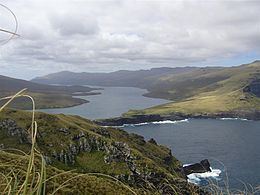Archipelago Auckland Islands Highest elevation 650 m (2,130 ft) Area 442.5 km² Max length 42 km | Width 26 km (16.2 mi) Highest point Cavern Peak Elevation 650 m Island group Auckland Islands | |
 | ||
Auckland Island is the main island of the Auckland Islands, an uninhabited archipelago in the south Pacific Ocean belonging to New Zealand. It is inscribed in the UNESCO World Heritage list together with the other subantarctic New Zealand islands in the region as follows: 877-004 Auckland Isls, New Zealand S50.29 E165.52 62560Ha 1998
Contents
Map of Auckland Island, New Zealand
Geography
The island has a land area of about 442.5 km2 (170.9 sq mi), and is 42 kilometres (26 mi) long. It is notable for its steep cliffs and rugged terrain, which rises to over 600 m (1,969 ft). Prominent peaks include Cavern Peak (650 m or 2,133 ft), Mount Raynal (635 m or 2,083 ft), Mount D'Urville (630 m or 2,067 ft), Mount Easton (610 m or 2,001 ft), and the Tower of Babel (550 m or 1,804 ft).
The southern end of the island broadens to a width of 26 km (16 mi). Here, a narrow channel known as Carnley Harbour (on some maps the Adams Straits) separates the main island from the smaller Adams Island . The channel is the remains of the crater of an extinct volcano, Adams Island and the southern part of the main island form the crater rim. 3 km (1.9 mi) north of Carnley Harbour's mouth lies Cape Lovitt, the westernmost point of New Zealand.
Fauna
The island is part of the Auckland Island group Important Bird Area (IBA), identified as such by BirdLife International because of the significance of the group as a breeding site for several species of seabirds as well as the endemic Auckland shag, Auckland teal, Auckland rail and Auckland snipe.
There are introduced Auckland Island pig, cats and mice are present on the island.
Goats were introduced to the Auckland Islands several times in the second half of the nineteenth century, to serve as a source of food for castaway sailors, with at least one liberation in 1865 on the main Auckland Island. By the 1970s, only one population remained, a group of about 100 based on the northwest side of Port Ross, in the north-east of the main island. In 1986 and 1987, over 60 animals were removed from the island for captive breeding in New Zealand. A decision was made to eradicate the remaining animals, an operation which was completed by 1992. An investigation in 1999 into the fate of the translocated animals in New Zealand found that the breed had become extinct.
In film
The 1955 film The Sea Chase has a German merchant ship fleeing from British and Australian naval ships at the beginning of World War II.
The ship stops at Auckland Island (the film was shot at Hawaii) to take victuals from the rescue station. A pro-Nazi officer shoots the three castaway fishermen he finds there, following which time another ship locates the corpses and chases the German ship.
The plot is inspired on the trip of Norddeutscher Lloyd steamer Erlangen.
